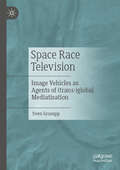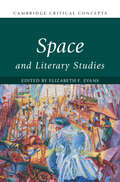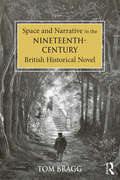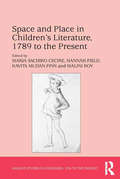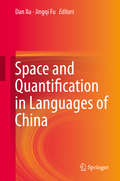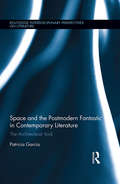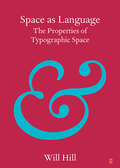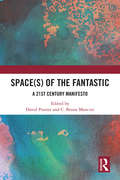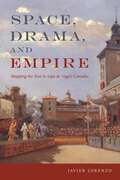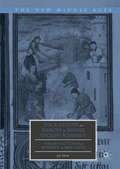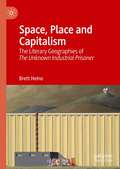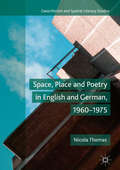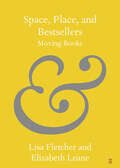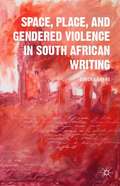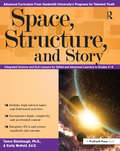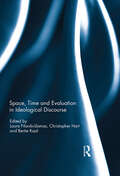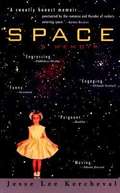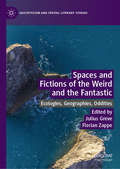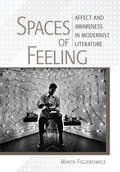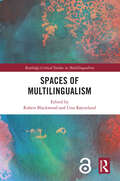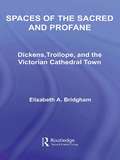- Table View
- List View
Space Race Television: Image Vehicles as Agents of (trans-)global Mediatisation
by Sven GramppThis volume offers a media-theoretically oriented perspective on the Space Race. It analyzes feature films, documentaries, live television coverage, magazines, stamps, posters, ticker-tape parades. They visualized the Space Race in a specific way and circulated it transnationally from 'East' to 'West' and from 'West' to 'East' across the 'Iron Curtain'. It will be shown how reporting on the Space Race between 1955 and 1975 can be explained as a globalizing history of the intertwining of images during the Cold War.
Space and Literary Studies (Cambridge Critical Concepts)
by Elizabeth F. EvansOur experience of the world is deeply shaped by concepts of space. From territorial borders, to distinctions between public and private space, to the way we dwell in a building or move between rooms, space is central to how we inhabit our environment and make sense of our place within it. Literature explores and gives expression to the ways in which space impacts human experience. It also powerfully shapes the construction and experience of space. Literary studies has increasingly turned to space and, fuelled by feminist and postcolonial insights, the interconnections between material spaces and power relations. This book treats foundational theories in spatial literary studies alongside exciting new areas of research, providing a dual emphasis on origins and innovative approaches while maintaining constant attention to how the production and experience of space is intertwined with the production and circulation of power.
Space and Narrative in the Nineteenth-Century British Historical Novel
by Tom BraggDemonstrating that nineteenth-century historical novelists played their rational, trustworthy narrators against shifting and untrustworthy depictions of space and place, Tom Bragg argues that the result was a flexible form of fiction that could be modified to reflect both the different historical visions of the authors and the changing aesthetic tastes of the reader. Bragg focuses on Scott, William Harrison Ainsworth, and Edward Bulwer Lytton, identifying links between spatial representation and the historical novel's multi-generic rendering of history and narrative. Even though their understanding of history and historical process could not be more different, all writers employed space and place to mirror narrative, stimulate discussion, interrogate historical inquiry, or otherwise comment beyond the rational, factual narrator's point of view. Bragg also traces how landscape depictions in all three authors' works inculcated heroic masculine values to show how a dominating theme of the genre endures even through widely differing versions of the form. In taking historical novels beyond the localized questions of political and regional context, Bragg reveals the genre's relevance to general discussions about the novel and its development. Nineteenth-century readers of the novel understood historical fiction to be epic and serious, moral and healthful, patriotic but also universal. Space and Narrative in the Nineteenth-Century British Historical Novel takes this readership at its word and acknowledges the complexity and diversity of the form by examining one of its few continuous features: a flexibly metaphorical valuation of space and place.
Space and Place in Children’s Literature, 1789 to the Present (Studies in Childhood, 1700 to the Present)
by Maria Sachiko Cecire Hannah Field Malini RoyFocusing on questions of space and locale in children’s literature, this collection explores how metaphorical and physical space can create landscapes of power, knowledge, and identity in texts from the early nineteenth century to the present. The collection is comprised of four sections that take up the space between children and adults, the representation of 'real world' places, fantasy travel and locales, and the physical space of the children’s book-as-object. In their essays, the contributors analyze works from a range of sources and traditions by authors such as Sylvia Plath, Maria Edgeworth, Gloria Anzaldúa, Jenny Robson, C.S. Lewis, Elizabeth Knox, and Claude Ponti. While maintaining a focus on how location and spatiality aid in defining the child’s relationship to the world, the essays also address themes of borders, displacement, diaspora, exile, fantasy, gender, history, home-leaving and homecoming, hybridity, mapping, and metatextuality. With an epilogue by Philip Pullman in which he discusses his own relationship to image and locale, this collection is also a valuable resource for understanding the work of this celebrated author of children’s literature.
Space and Quantification in Languages of China
by Dan Xu Jingqi FuThis volume provides general linguists with new data and analysis on languages spoken in China regarding various aspects of space and quantification, using different approaches. Contributions by researchers from Mainland China, Hong Kong, Japan, Europe, the United States and Australia offer insights on aspects of language ranging from phonology and morphology to syntax and semantics, while the approaches vary from formal, historical, areal, typological, and cognitive linguistics to second language acquisition. After separate volumes on space and quantification in languages of China, the studies in this volume combine space and quantification to allow readers a view of the intersection of the two topics. Each article contributes to general linguistic knowledge while discussing a particular aspect of space or quantification in a particular language/dialect, offering new data and analysis from languages that are spoken in the same geographical area, and that belong to various language families that exist and evolve in close contact with one another.
Space and the Postmodern Fantastic in Contemporary Literature: The Architectural Void (Routledge Interdisciplinary Perspectives on Literature)
by Patricia GarciaArising from the philosophical conviction that our sense of space plays a direct role in our apprehension and construction of reality (both factual and fictional), this book investigates how conceptions of postmodern space have transformed the history of the impossible in literature. Deeply influenced by the work of Jorge Luis Borges and Julio Cortázar, there has been an unprecedented rise in the number of fantastic texts in which the impossible is bound to space — space not as scene of action but as impossible element performing a fantastic transgression within the storyworld. This book conceptualizes and contextualizes this postmodern, fantastic use of space that disrupts the reader’s comfortable notion of space as objective reality in favor of the concept of space as socially mediated, constructed, and conventional. In an illustration of the transnational nature of this phenomenon, García analyzes a varied corpus of the Fantastic in the past four decades from different cultures and languages, merging literary analysis with classical questions of space related to the fields of philosophy, urban studies, and anthropology. Texts include authors such as Julio Cortázar (Argentina), John Barth (USA), J.G. Ballard (UK), Jacques Sternberg (Belgium), Fernando Iwasaki (Perú), Juan José Millás (Spain,) and Éric Faye (France). This book contributes to Literary Theory and Comparative Literature in the areas of the Fantastic, narratology, and Geocriticism and informs the continuing interdisciplinary debate on how human beings make sense of space.
Space as Language: The Properties of Typographic Space (Elements in Publishing and Book Culture)
by Will HillThis Element examines the function and significance of typographic space. It considers in turn the space within letters, the space between letters, the space between lines, and the margin space surrounding the text-block, to develop the hypothesis that viewed collectively these constitute as a 'metalanguage' complementary to the text. Drawing upon critical perspectives from printing, typeface design, typography, avant-garde artistic practice and design history, the Element examines the connotative values and philosophies embodied in the form and disposition of space. These include the values attributed to symmetry and asymmetry, the role of 'active' space in the development of modernist typography, the debated relationship between type and writing, the divergent ideologies of the printing industry and the letter arts, and the impact of successive technologies upon both the organisation and the perception of typographic space.
Space in Medieval Romance: Constructing Narrative Space in the Middle English Breton Lays (Geocriticism and Spatial Literary Studies)
by Fanny MoghaddassiThis book explores the connections between space and narrative through an in-depth analysis of the fourteenth-century Middle English Breton lays. The work employs a range of critical approaches pertaining to the spatial turn and geocriticism and presents a nuanced account of the construction of narrative space in fourteenth-century English romance. In her study, Fanny Moghaddassi offers a theoretical reflection on the literary specificities of romance space, provides an examination of the social, political, and ideological tensions at work in its representation, and considers medieval practices of space, both from a collective and a more individual point of view.
Space(s) of the Fantastic: A 21st Century Manifesto
by David Punter; C. Bruna ManciniThis book provides a series of new addresses to the enduring problem of how to categorize the Fantastic. The approach taken is through the lens of spatiality; the Fantastic gives us new worlds, although of course these are refractions of worlds already in being. In place of ‘real’ spaces (whatever they might be), the Fantastic gives us imaginary spaces, although within those spaces historical and cultural conflicts are played out, albeit in forms that stretch our understanding of everyday location, and our usual interpretations of cause and effect. Many authors are addressed here, from a variety of different geographical and national traditions, thus demonstrating how the Fantastic - as a mode, a genre, a way of thinking, imagining and writing - continually traverses borders and boundaries. We hope to move the ongoing debate about the Fantastic forward in a scholarly as well as an engaging way.
Space, Drama, and Empire: Mapping the Past in Lope de Vega's Comedia (Campos Ibéricos: Bucknell Studies in Iberian Literatures and Cultures)
by Javier LorenzoSpanish poet, playwright, and novelist Félix Lope de Vega (1562–1635) was a key figure of Golden Age Spanish literature, second only in stature to Cervantes, and is considered the founder of Spain’s classical theater. In this rich and informative study, Javier Lorenzo investigates the symbolic use of space in Lope’s drama and its function as an ideological tool to promote an imagined Spanish national past. In specific plays, this book argues, historical landscapes and settings were used to foretell and legitimize the imperial present in Hapsburg Spain, allowing audiences to visualize and plot, as on a map, the country’s expansionist trajectory throughout the centuries. By focusing on connections among space, drama, and empire, this book makes an important contribution to the study of literature and imperialism in early modern Spain and equally to our understanding of the role and political significance of spatiality in Siglo de Oro comedia.
Space, Gender, and Memory in Middle English Romance
by Jan ShawThis book offers a much-needed consideration of Melusine within medieval and contemporary theories of space, memory, and gender. The Middle English Melusine offers a particularly rich source for such a study, as it presents the story of a powerful fairy/human woman who desires a full human life--and death--within a literary tradition that is more friendly to women's agency than its continental counterparts. After establishing a "textual habitus of wonder," Jan Shaw explores the tale in relation to a range of Middle English traditions including love and marriage, the spatial practices of women, the operation of individual and collective memory, and the legacies of patrimony. Melusine emerges as a complex figure, representing a multifaceted feminine subject that furthers our understanding of Middle English women's sense of self in the world.
Space, Place and Autonomy in Language Learning (Routledge Research in Language Education)
by Garold Murray Terry LambThis book explores theories of space and place in relation to autonomy in language learning. Encompassing a wide range of linguistically and culturally diverse learning contexts, this edited collection brings together research papers from academics working in fourteen countries. In their studies, these researchers examine physical, virtual and metaphorical learning spaces from a wide range of theoretical and interdisciplinary perspectives (semiotic, ecological, complexity, human geography, linguistic landscapes, mediated discourse analysis, sociocultural, constructivist and social constructivist) and methodological approaches. The book traces its origins to the first-ever symposium on space, place and autonomy, which was held at the International Association of Applied Linguistics (AILA) 2014 World Congress in Brisbane. The final chapter, which presents a thematic analysis of the papers in this volume, discusses the implications for theory development, further enquiry, and pedagogical practice.
Space, Place and Capitalism: The Literary Geographies of The Unknown Industrial Prisoner
by Brett HeinoThis book is an original contribution to literary geography and commentaries on the work of David Ireland. It plots the relationship between the spaces and places of 1970s Australian capitalism as it evolves through Ireland’s 1971 Miles Franklin prize-winning novel The Unknown Industrial Prisoner. In particular, the book theorises the relationship between space and place in literature through two highly innovative arguments: a focus on the spatial unconscious as a means to assess and track the spatiality of capitalism in the novel form; and the articulation of a regime of space through the perceived, conceived and lived constitution of space. Drawing together concepts from radical geography and structural Marxist literary theory, it explores the dominance of the regime of abstract space in the Australian context. The text also examines the nature and possibilities of place-based strategies of resistance, and concludes by suggesting opportunities for future research and plotting the ways in which The Unknown Industrial Prisoner continues to speak to contemporary Australia.
Space, Place and Poetry in English and German, 1960–1975 (Geocriticism and Spatial Literary Studies)
by Nicola ThomasSpace, Place and Poetry in English and German, 1960-1975 examines the work of Paul Celan, J. H. Prynne, Derek Mahon, Sarah Kirsch, Edwin Morgan and Ernst Jandl, bringing together postwar English- and German-language poetry and criticism on the theme of space, place and landscape. Nicola Thomas highlights hitherto underexplored connections between a wide range of poets working across the two language areas, demonstrating that space and place are vital critical categories for understanding poetry of this period. Thomas’s analysis reveals weaknesses in existing critical taxonomies, arguing for the use of ‘late modernist’ as a category with cross-cultural relevance, and promotes methodological exchange between the Anglophone and German traditions of landscape, space and place oriented poetic criticism, to the benefit of both.
Space, Place, and Bestsellers: Moving Books (Elements in Publishing and Book Culture)
by Lisa Fletcher Elizabeth LeaneFrom airport bookstores to deckchairs, as audiobooks downloaded by commuters, and on Kindles and other portable devices, twenty-first century bestsellers move in old and new ways. This Element examines the locations and mobilities of the contemporary bestseller as a multi-format commercial object. It employs paratextual, textual, and site-based analysis of the spatiality of bestsellers and considers the centrality of geography to the commercial promise of these books. Space, Place, and Bestsellers provides analysis of the spatial logic of bestseller lists, evidence-rich accounts of the physical and digital retail sites through which bestsellers flow, and new interpretations of how affixing the label 'bestseller' individual authors and titles generates industrial, social, and textual effects. Through its multi-layered analysis, this Element offers a new model for studying the spatiality of popular fiction.
Space, Place, and Gendered Violence in South African Writing
by Sorcha GunneGendered violence constitutes a unique form of violence because it is at once both intensely political and intensely personal. Exploring the relationship between space, place, and gendered violence as depicted in a range of South African writing, Gunne examines the social and political conditions of exceptionality during and after apartheid. As a case study, South Africa offers considerable potential for analysis because the governmental technology of apartheid affected not only race relations, but also gendered and spatial ones. This resulted in conditions of exceptionality that operate on the levels of institutional power and political allegory, but yet had, and still have, an immense impact on the everyday. This book focuses on how narrative representations of gendered violence document, negotiate, challenge and resist structures of domination and power.
Space, Structure, and Story: Integrated Science and ELA Lessons for Gifted and Advanced Learners in Grades 4-6
by Tamra Stambaugh Emily MofieldWinner of the 2017 NAGC Curriculum Studies Award Space, Structure, and Story integrates Earth and space science with science fiction and nonfiction texts, poetry, and art. This unit, developed by Vanderbilt University's Programs for Talented Youth, is aligned to the Common Core State Standards and Next Generation Science Standards. Students explore advanced science and ELA content through the lens of structure—its parts, purpose, and function. Mobius strips, the hero's journey, dystopian fiction, black holes, Einstein's relativity, stars, and moons are just a few of the captivating in-depth topics explored through accelerated content, engaging activities, and differentiated tasks. Ideal for gifted classrooms or gifted pull-out groups, the unit features poetry from Carl Sandburg, Henry Wadsworth Longfellow, and C. S. Lewis; art from M. C. Escher, Vincent Van Gogh, Claude Monet, and Salvador Dali; a novel study featuring A Wrinkle in Time by Madeleine L'Engle; short stories from Isaac Asimov and Ray Bradbury; speeches from President John F. Kennedy and President Barack Obama; and informational texts about gravity, orbits, and black holes. Grades 4-6
Space, Time and Evaluation in Ideological Discourse
by Christopher Hart Laura Filardo-Llamas Bertie KaalBringing together a body of related research which has recently developed in Critical Discourse Analysis, this book is the first to address the role of perspective in socio-political discourse. Specifically, the contributions to this volume seek to explore, from a cognitive standpoint, the way in which perspective functions in three dimensions – space, time, and evaluation – to enact ideology and persuasion. A range of discourse genres are analysed, including political discourse, media discourse, and songs used as political tools. Starting from the contention that discourse processing relies on the same mechanisms that support our understanding and experience of space, the book finds a recurrent theme in the way in which perspectival concepts like distance and focus, prompted by linguistic signs, feature in our discursively constructed knowledge of social and political realities. By highlighting the complex nature of perspective-taking in ideological discourse, the volume sets the agenda for further research in this area. The book will appeal to linguists, discourse analysts, media scholars, and political scientists, and all who are interested in the relationship between language and cognition in the socio-political domain. This book was originally published as a special issue of Critical Discourse Studies.
Space-Time: Studies in the Symbolic (Re-)appropriation of Public Space (Routledge Studies in Sociolinguistics)
by Isabelle Buchstaller, Małgorzata Fabiszak, and Melody Ann RossThis collection spotlights the diachronic dimensions of the linguistic landscape, the importance of exploring temporal dissonances in historical events in order to better understand semiotic, political, and social transformations across different communities over the last century.The volume seeks to expand the current borders of linguistic landscape (LL) research by situating the analysis of signs in the LL within their time–space organization, which has been understudied in existing scholarship. The book, featuring chapters from established and emerging scholars, argues that a focus on the historicity of the city text can reveal unique insights into the role of semiotic processes as precursors and support mechanisms for political and social changes. The collection is structured around different temporal clusters and geographic contexts across the globe where shorter and longer waves of politically driven resemioticization can be most sharply observed – post-colonial communities; post-communist societies; and recent and current sociopolitical upheavals. Taken together, the volume proposes a kaleidoscope view of the complex temporalities that underpin multimodal discourses in contested public spaces, offering new directions for LL research.This book will be of interest to students and scholars in sociolinguistics, discourse analysis, semiotics, visual anthropology, and political science.The Introduction and Chapter 8 of this book is freely available as a downloadable Open Access PDF at http://www.taylorfrancis.com under a Creative Commons Attribution-Non Commercial-No Derivatives (CC-BYNC-ND) 4.0 license.
Space: A Memoir
by Jesse Lee KerchevalKercheval remembers her days growing up in Florida, her mother addicted to Valium and her father turning into a workaholic.
Spaces and Fictions of the Weird and the Fantastic: Ecologies, Geographies, Oddities (Geocriticism and Spatial Literary Studies)
by Julius Greve Florian ZappeThis collection of essays discusses genre fiction and film within the discursive framework of the environmental humanities and analyses the convergent themes of spatiality, climate change, and related anxieties concerning the future of human affairs, as crucial for any understanding of current forms of “weird” and “fantastic” literature and culture. Given their focus on the culturally marginal, unknown, and “other,” these genres figure as diagnostic modes of storytelling, outlining the latent anxieties and social dynamics that define a culture’s “structure of feeling” at a given historical moment. The contributions in this volume map the long and continuous tradition of weird and fantastic fiction as a seismograph for eco-geographical turmoil from the nineteenth to the twenty-first century, offering innovative and insightful ecocritical readings of H. P. Lovecraft, Harriet Prescott Spofford, China Miéville, N. K. Jemisin, Thomas Ligotti, and Jeff VanderMeer, among others.
Spaces for Nostalgia: Difficult Memories and Material Consolations (Palgrave Studies in Cultural Heritage and Conflict)
by Mario PanicoHow is nostalgia expressed through space? Studies of nostalgia have long illustrated the emotional dynamics which condition our desire to go back to a time and a space that belong to the past. This book addresses this condition from an innovative perspective, by over-exposing the spatial dimension of nostalgia. Doing so unveils alternative and complementary ways of thinking through how this emotion is activated: in particular, how space – unlike time – can be recreated in the present, even in a different location, with the deliberate aim of consoling this bittersweet sensation. The volume defines this re-creation as a “space for nostalgia”. In this book, this concept is applied within the context of cultural heritage and difficult memories. As a further step, then, the volume questions the modalities through which nostalgia can interact with and permeate a space of memory, therefore influencing collective understandings and the emotional re-writings of our shared pasts. Through case studies relating to challenging nostalgias for troubled pasts in Western Europe, the book examines how the furnishing and use of space, the discourses that surround it, and the objects that become synecdoche of it provide a terrain where even unlikely or troubling forms of nostalgia can grow and blossom.
Spaces of Feeling: Affect and Awareness in Modernist Literature
by Marta FiglerowiczCan other people notice our affects more easily than we do? In Spaces of Feeling, Marta Figlerowicz examines modernist novels and poems that treat this possibility as electrifying, but also deeply disturbing. Their characters and lyric speakers are undone, Figlerowicz posits, by the realization that they depend on others to solve their inward affective conundrums—and that, to these other people, their feelings often do not seem mysterious at all.Spaces of Feeling features close readings of works by Virginia Woolf, James Baldwin, John Ashbery, Ralph Ellison, Marcel Proust, F. Scott Fitzgerald, Sylvia Plath, and Wallace Stevens. Figlerowicz points out that these poets and novelists often place their protagonists in domestic spaces—such as bedrooms, living rooms, and basements—in which their cognitive dependence on other characters inhabiting these spaces becomes clear. Figlerowicz highlights the diversity of aesthetic and sociopolitical contexts in which these affective dependencies become central to these authors' representations of selfhood. By setting these novels and poems in conversation with the work of contemporary theorists, she illuminates pressing and unanswered questions about subjectivity.
Spaces of Multilingualism (Routledge Critical Studies in Multilingualism)
by Robert Blackwood and Unn RøynelandThis innovative collection explores critical issues in understanding multilingualism as a defining dimension of identity creation and negotiation in contemporary social life. Reinforcing interdisciplinary conversations on these themes, each chapter is co-authored by two different researchers, often those who have not written together before. The combined effect is a volume showcasing unique and dynamic perspectives on such topics as rethinking of language policy, testing of language rights, language pedagogy, meaning-making, and activism in the linguistic landscape. The book explores multilingualism through the lenses of spaces and policies as embodied in Elizabeth Lanza’s body of work in the field, with a focus on the latest research on linguistic landscapes in diverse settings. Taken together, the book offers a window into better understanding issues around processes of change in and of languages and societies. This ground breaking volume will be of particular interest to students and scholars in multilingualism, applied linguistics, and sociolinguistics.
Spaces of the Sacred and Profane: Dickens, Trollope, and the Victorian Cathedral Town (Literary Criticism and Cultural Theory)
by Elizabeth A. BridghamThis study examines the unique cultural space of Victorian cathedral towns as they appear in the literary work of Charles Dickens and Anthony Trollope, arguing that Dickens and Trollope use the cathedral town’s enclosure, and its overt connections between sacred and secular, present and past, as an ideal locus from which to critique Victorian religious attitudes, aesthetic anxieties, business practices, and even immigration. By displacing these issues from the metropolis, these social authors defamiliarize them, raising what might have been considered strictly urban problems to the level of national crises. By situating contemporary debates in cathedral towns, Dickens and Trollope complicate the restrictive dichotomy between urban and rural space often drawn by contemporary critics and Victorian fiction writers alike. In this book, Bridgham focuses on the appearance of three such key concerns appearing in the cathedral towns of each writer: religious fragmentation, the social value of artistic labor, and the Gothic revival. Dickens and Trollope reject Romantic nostalgia by concentrating on the ancient, yet vital (as opposed to ruined) edifices of the cathedrals, and by demonstrating ways in which modern sensibilities, politics, and comforts supersede the values of the cloister. In this sense, their cathedral towns are not idealized escapes; rather, they reflect the societies of which they are a part.
